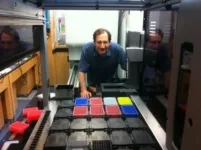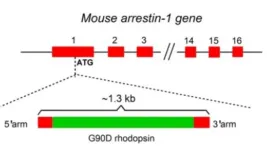(Press-News.org) CHAPEL HILL, N.C. – Artificial intelligence (AI) has numerous applications in healthcare, from analyzing medical imaging to optimizing the execution of clinical trials, and even facilitating drug discovery.
AlphaFold2, an artificial intelligence system that predicts protein structures, has made it possible for scientists to identify and conjure an almost infinite number of drug candidates for the treatment of neuropsychiatric disorders. However recent studies have sown doubt about the accuracy of AlphaFold2 in modeling ligand binding sites, the areas on proteins where drugs attach and begin signaling inside cells to cause a therapeutic effect, as well as possible side effects.
In a new paper, Bryan Roth, MD, PhD, the Michael Hooker Distinguished Professor of Pharmacology and director of the NIMH Psychoactive Drug Screening Program at the University of North Carolina School of Medicine, and colleagues at UCSF, Stanford and Harvard determined that AlphaFold2 can yield accurate results for ligand binding structures, even when the technology has nothing to go off of. Their results were published in Science.
“Our results suggest that AF2 structures can be useful for drug discovery,” said Roth, senior author who holds a joint appointment at the UNC Eshelman School of Pharmacy. “With a nearly infinite number of possibilities to create drugs that hit their intended target to treat a disease, this sort of AI tool can be invaluable.”
AlphaFold2 and Prospective Modeling
Much like weather forecasting or stock market prediction, AlphaFold2 works by pulling from a massive database of known proteins to create models of protein structures. Then, it can simulate how different molecular compounds (like drug candidates) fit into the protein’s binding sites and produce wanted effects. Researchers can use the resulting combinations to better understand protein interactions and create new drug candidates.
To determine the accuracy of AlphaFold2, researchers had to compare the results of a retrospective study against that of a prospective study. A retrospective study involves researchers feeding the prediction software compounds they already know bind to the receptor. Whereas, a prospective study requires researchers to use the technology as a fresh slate, and then feed the AI platform information about compounds that may or may not interact with the receptor.
Researchers used two proteins, sigma-2 and 5-HT2A, for the study. These proteins, which belong to two different protein families, are important in cell communication and have been implicated in neuropsychiatric conditions such as Alzheimer’s disease and schizophrenia. The 5-HT2A serotonin receptor is also the main target for psychedelic drugs which show promise for treating a large number of neuropsychiatric disorders.
Roth and colleagues selected these proteins because AlphaFold2 had no prior information about sigma-2 and 5-HT2A or the compounds that might bind to them. Essentially, the technology was given two proteins for which it wasn’t trained on -- essentially giving the researchers a “blank slate.”
First, researchers fed the AlphaFold system the protein structures for sigma-2 and 5-HT2A, creating a prediction model. Researchers then accessed physical models of the two proteins that were produced using complex microscopy and x-ray crystallography techniques. With a press of a button, as many as 1.6 billion potential drugs were targeted to the experimental models and AlphaFold2 models. Interestingly, every model had a different drug candidate outcome.
Successful Hit Rates
Despite the models having differing results, they show great promise for drug discovery. Researchers determined that the proportion of compounds that actually altered protein activity for each of the models were around 50% and 20% for the sigma-2 receptor and 5-HT2A receptors, respectively. A result greater than 5% is exceptional.
Out of the hundreds of millions of potential combinations, 54% of the drug-protein interactions using the sigma-2 AlphaFold2 protein models were successfully activated through a bound drug candidate. The experimental model for sigma-2 produced similar results with a success rate of 51%.
“This work would be impossible without collaborations among several leading experts at UCSF, Stanford, Harvard, and UNC-Chapel Hill,” Roth said. “Going forward we will test whether these results might be applicable to other therapeutic targets and target classes.”
END
Researchers wrestle with accuracy of AI technology used to create new drug candidates
2024-05-16
ELSE PRESS RELEASES FROM THIS DATE:
Breaking bonds to form bonds: Rethinking the Chemistry of Cations
2024-05-16
A team of chemists from the University of Vienna, led by Nuno Maulide, has achieved a significant breakthrough in the field of chemical synthesis, developing a novel method for manipulating carbon-hydrogen bonds. This groundbreaking discovery provides new insights into the molecular interactions of positively charged carbon atoms. By selectively targeting a specific C–H bond, they open doors to synthetic pathways that were previously closed – with potential applications in medicine. The study was recently published in the prestigious journal Science.
Living ...
New gene delivery vehicle shows promise for human brain gene therapy
2024-05-16
In an important step toward more effective gene therapies for brain diseases, researchers from the Broad Institute of MIT and Harvard have engineered a gene-delivery vehicle that uses a human protein to efficiently cross the blood-brain barrier and deliver a disease-relevant gene to the brain in mice expressing the human protein. Because the vehicle binds to a well-studied protein in the blood-brain barrier, the scientists say it has a good chance at working in patients.
Gene therapy could potentially treat a range of severe genetic brain disorders, which currently ...
Finding quantum order in chaos
2024-05-16
If you zoom in on a chemical reaction to the quantum level, you’ll notice that particles behave like waves that can ripple and collide. Scientists have long sought to understand quantum coherence, the ability of particles to maintain phase relationships and exist in multiple states simultaneously; this is akin to all parts of a wave being synchronized. It has been an open question whether quantum coherence can persist through a chemical reaction where bonds dynamically break and form.
Now, for the first time, a team of Harvard scientists has demonstrated the survival of quantum coherence in a chemical reaction involving ultracold molecules. These findings highlight the potential of ...
Study suggests high-frequency electrical ‘noise’ results in congenital night blindness
2024-05-16
In what they believe is a solution to a 30-year biological mystery, neuroscientists at Johns Hopkins Medicine say they have used genetically engineered mice to address how one mutation in the gene for the light-sensing protein rhodopsin results in congenital stationary night blindness.
The condition, present from birth, causes poor vision in low-light settings.
The findings, published May 14 in Proceedings of the National Academy of Sciences, demonstrate that the rhodopsin gene mutation, called ...
TeltoHeart wristband, developed by Lithuanians, receives important medical device certification
2024-05-16
Teltonika’s TeltoHeart, a multifunctional smart wristband system developed in cooperation between Lithuanian industry and universities has been given the CE MDR (Class IIa) medical device certification. This approval confirms that the product meets the comprehensive quality standards for medical devices and opens up new markets worldwide for this innovative product.
"This is an important recognition that we have been working towards since the start of this project in 2020. The CE MDR certification proves that TeltoHeart is a safe ...
Unique brain circuit is linked to Body Mass Index
2024-05-16
· One region is related to olfaction and reward, the other to negative feelings like pain · When the connection between these brain regions is weak, people have higher BMI
· Food may continue to be rewarding, even when these individuals are full
CHICAGO --- Why can some people easily stop eating when they are full and others can’t, which can lead to obesity?
A Northwestern Medicine study has found one reason may be a newly discovered structural connection ...
Noise survey highlights need for new direction at Canadian airports #ASA186
2024-05-16
OTTAWA, Ontario, May 16, 2024 – The COVID-19 pandemic changed life in many ways, including stopping nearly all commercial flights. At the Toronto Pearson International Airport, airplane traffic dropped by 80% in the first few months of lockdown. For a nearby group of researchers, this presented a unique opportunity.
Julia Jovanovic will present the results of a survey conducted on aircraft noise and annoyance during the pandemic era Thursday, May 16, at 11:10 a.m. EDT as part of a joint meeting of the Acoustical Society of America and ...
COSPAR partners with LASP for 1st COSPAR Center of Excellence
2024-05-16
Partnering with LASP was an obvious decision for COSPAR. LASP stands out with its distinguished track record in space science research, having deployed scientific instruments to every planet in our solar system, the Sun and numerous moons. In particular, LASP has been at the forefront of pioneering Cube-Sat missions, consistently achieving remarkable success in gathering scientific data. With seven completed CubeSat missions and nine more in active development or orbit, LASP has demonstrated unparalleled expertise in this field. ...
Building a better sarcasm detector #ASA186
2024-05-16
OTTAWA, Ontario, May 16, 2024 – Oscar Wilde once said that sarcasm was the lowest form of wit, but the highest form of intelligence. Perhaps that is due to how difficult it is to use and understand. Sarcasm is notoriously tricky to convey through text — even in person, it can be easily misinterpreted. The subtle changes in tone that convey sarcasm often confuse computer algorithms as well, limiting virtual assistants and content analysis tools.
Xiyuan Gao, Shekhar Nayak, and Matt Coler of Speech Technology Lab at the University of Groningen, Campus Fryslân developed a multimodal algorithm ...
Natural toxins in food: Many people are not aware of the health risks
2024-05-16
Many people are concerned about residues of chemicals, contaminants or microplastics in their food. However, it is less well known that many foods also contain toxins of completely natural origin. These are often chemical compounds that plants use to ward off predators such as insects or microorganisms. These substances are found in beans and potatoes, for example, and can pose potential health risks. However, according to a recent representative survey by the German Federal Institute for Risk Assessment (BfR), only just under half of the respondents (47 per cent) were even aware of plant toxic substances. The BfR Consumer Monitor Special on naturally occurring plant toxins ...






